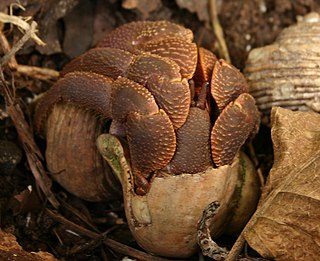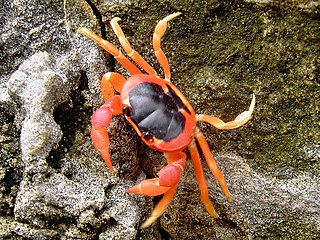
Hermit crabs are anomuran decapod crustaceans of the superfamily Paguroidea that have adapted to occupy empty scavenged mollusc shells to protect their fragile exoskeletons. There are over 800 species of hermit crab, most of which possess an asymmetric abdomen concealed by a snug-fitting shell. Hermit crabs' soft (non-calcified) abdominal exoskeleton means they must occupy shelter produced by other organisms or risk being defenseless.

Emerita is a small genus of decapod crustaceans, known as sand crabs, or mole crabs. These small animals burrow in the sand in the swash zone and use their antennae for filter feeding.

The Caribbean hermit crab, also known as the soldier crab, West Atlantic crab, tree crab, or purple pincher, is a species of land hermit crab native to the west Atlantic, Belize, southern Florida, Venezuela, and the West Indies.

The Australian land hermit crab is a terrestrial hermit crab species, native to Australia. It is a nocturnal, omnivorous crustacean. They are gregarious and thrive in tropical areas near water.

The Coenobitidae are the family of terrestrial hermit crabs, widely known for their land-living habits as adults. They are found in coastal tropical regions around the world and require access to the ocean to breed.

Cancer is a genus of marine crabs in the family Cancridae. It includes eight extant species and three extinct species, including familiar crabs of the littoral zone, such as the European edible crab, the Jonah crab and the red rock crab. It is thought to have evolved from related genera in the Pacific Ocean in the Miocene.

Coenobita perlatus is a species of terrestrial hermit crab. It is known as the strawberry hermit crab because of its reddish-orange colours. It is a widespread scavenger across the Indo-Pacific, and wild-caught specimens are traded to hobby aquarists.

Coenobita cavipes is a species of land hermit crab native to the eastern parts of Africa, the Indonesia, Philippines, China, Japan, Malaysia, Taiwan, Polynesia, and Micronesia. While these hermit crabs are terrestrial, they prefer to reside near the shores for access of both water and land.

Coenobita brevimanus is a species of terrestrial hermit crab belonging to the family Coenobitidae, which is composed of coastal living terrestrial hermit crabs. From there it belongs to the genus Coenobita, one of two genera split from the family, which contains sixteen species. The Latin origins of the species name, brevimanus, come from the adjective brevis ("small") and the noun manus ("hands"). It is known as the Indos crab or Indonesian crab because it is primarily distributed throughout the Indo-Pacific.

Gecarcinus lateralis, also known by the common names blackback land crab, Bermuda land crab, red land crab and moon crab, is a colourful crab from the family Gecarcinidae.

The coconut crab is a terrestrial species of giant hermit crab, and is also known as the robber crab or palm thief. It is the largest terrestrial arthropod known, with a weight of up to 4.1 kg (9 lb). The distance from the tip of one leg to the tip of another can be as wide as 1 m. It is found on islands across the Indian and Pacific Oceans, as far east as the Gambier Islands, Pitcairn Islands and Caroline Island and as far south as Zanzibar. While its range broadly shadows the distribution of the coconut palm, the coconut crab has been extirpated from most areas with a significant human population such as mainland Australia and Madagascar.

Thermonectus is a genus of beetle in family Dytiscidae. This genus is native to the New World, and mainly from warm temperate to tropical in distribution, but one species, T. basillaris occurs as far north as southern Ontario, Canada. They inhabit a wide range of freshwater habitats with static water and are often common. They are generally about 0.8–1.5 cm (0.3–0.6 in) long and a few species from desert pools in North America have a distinct yellow-spotted pattern on a black background.

Diogenes pugilator is a species of hermit crab, sometimes called the small hermit crab or south-claw hermit crab. It is found from the coast of Angola to as far north as the North Sea, and eastwards through the Mediterranean Sea, Black Sea and Red Sea. Populations of D. pugilator may be kept in check by the predatory crab Liocarcinus depurator.

The Aeglidae are a family of freshwater crustaceans currently restricted to South America. They are the only anomurans to be found in fresh water except for a single hermit crab species, Clibanarius fonticola, on Espiritu Santo, Vanuatu. They live between 20° S and 50° S, at altitudes between 320 and 3,500 m (1,050–11,480 ft).
Calcinus tubularis is a species of hermit crab. It is found in the Mediterranean Sea and around islands in the Atlantic Ocean, where it lives below the intertidal zone. Its carapace, eyestalks and claws are marked with numerous red spots. C. tubularis and its sister species, C. verrilli, are the only hermit crabs known to show sexual dimorphism in shell choice, with males using normal marine gastropod shells, while females use shells of gastropods in the family Vermetidae, which are attached to rocks or other hard substrates.

Around 1,300 species of freshwater crabs are distributed throughout the tropics and subtropics, divided among eight families. They show direct development and maternal care of a small number of offspring, in contrast to marine crabs, which release thousands of planktonic larvae. This limits the dispersal abilities of freshwater crabs, so they tend to be endemic to small areas. As a result, a large proportion are threatened with extinction.

Coenobita scaevola is a species of terrestrial hermit crab from the western Indian Ocean and Red Sea.
Coenobita lila is a species of land hermit crab in the genus Coenobita Latreille, 1829. Coenobita lila is described from Singapore, Malaysia and Indonesia.
Coenobita rubescens is a species of terrestrial (land-living) hermit crab, family Coenobitidae.

Labidochirus splendescens, commonly known as the splendid hermit crab, is a species of hermit crab found in the northeastern Pacific Ocean off the coast of North America. It is more heavily calcified and inhabits smaller mollusc shells than most hermit crabs.



























